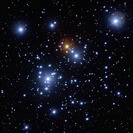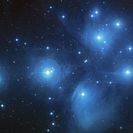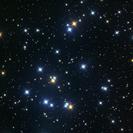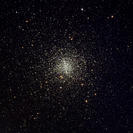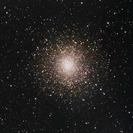Star clusters are groups of stars which are gravitationally bound together. The average star distance in a star cluster is much smaller than the average distance between stars in the rest of the galaxy. Basically there are two types of star clusters:
- Globular clusters are groups of 10000 to several million stars, densely packed together in a spherical form. They consist of very old stars, many billion years of age. Most of these stars are just a few hundred million years younger than the universe itself, meaning that typical ages for globular star clusters are 12 to 13 billion years. These globular clusters are not part of the galaxies themselves, they orbit around them. The Milky Way is, for example, accompanied by 150 globular clusters; bigger galaxies like the Andromeda galaxy are orbited by about 500 globular clusters and the biggest galaxies (like M87) have 10000 and more clusters in orbit.
- On the other hand we have open clusters, which have almost all the opposite characteristics of globular clusters: they contain less stars (less than a few hundred), they are less dense and very young. Open clusters are the places where all new stars are born; 4.6 billion years ago our Sun was born in an open cluster too. Because they are less dense, they are less tightly gravitationally bound together; that's why they disintegrate over time. This has also happened to our solar system which has moved from an open star cluster to a relatively empty region in the Milky Way. Since open star clusters are the places where new stars are born, they are often surrounded by huge clouds of gas and dust, which can give rise to fantastic places in space like the Pillars of Creation.

